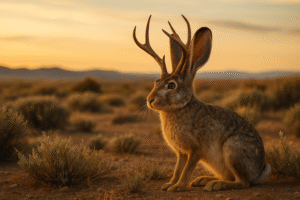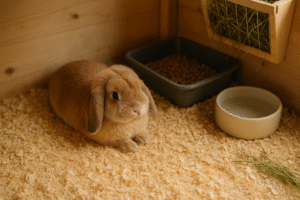Picture this: you’re strolling through your yard on a beautiful sunny day, and you come across a baby rabbit nest hidden in the grass. What should you do? “What to do if you find a baby rabbit in your yard” is a question many people ask. How can you ensure the safety and well-being of these fragile creatures? This compassionate guide will walk you through the steps to take when you find a baby rabbit nest in your yard, from identification to prevention and legal considerations.
Key Takeaways
Identify baby rabbit nests in your yard by looking for slight depressions or cavities, fur forming the nest, and activity from the mother entering/leaving.
Observe from a distance & keep pets away. Contact wildlife rehabilitation experts when caring for orphaned/injured rabbits.
Prevent future nests with landscaping techniques & natural deterrents, while understanding legal/ethical requirements related to managing populations humanely.
Identifying a Baby Rabbit Nest in Your Yard

It might surprise you to find a rabbit nest in your yard. Knowing how to spot one is key to avoiding causing disruption and guarding the baby rabbits’ safety. Typical indications of a wild rabbit nest include:
A slight depression or cavity in the ground
The presence of fur forming the nest
Activity or presence of the mother rabbit entering and leaving the nest
Recognizing usual nesting spots and the nesting season of rabbits can equip you to respond appropriately.
Common Nesting Locations
Rabbit nests, also known as rabbit nests, can be found in various locations, such as backyards, parks, and urban areas, sometimes even leading to a rabbit infestation. Most commonly, they appear as shallow ground depressions covered with dried vegetation. Therefore, it’s wise to check your yard carefully before mowing to prevent any accidental harm to the baby rabbits.
Nests are often located near bushes or trees and beneath or close to covered porches and sheds. Rabbits use dead grass and twigs to construct their nests, and some adult rabbits will persistently utilize a nesting spot if the conditions are suitable, while others prefer to construct a new nest each time.
Time of Year for Rabbit Nests
Rabbit nesting season generally occurs between mid-March and early September. During this time, you may notice an increase in rabbit activity in your yard and surrounding areas. Female rabbits, also known as does, are responsible for constructing nests and caring for their offspring. They typically visit the nest at dusk and dawn to nurse the babies.
Awareness of the nesting season and signs of a mother rabbit nearby enables you to act suitably, ensuring the protection of both the rabbits and your yard.
What to Do When You Discover a Baby Rabbit Nest

If you happen to find a rabbit nest in your yard, be sure to tread carefully and avoid any disturbance. Refrain from handling the baby rabbits and mark the area to ensure the nest is not disturbed inadvertently.
The steps mentioned below guide you on how to view the nest safely from a distance, keep your pets at bay, and ensure the baby rabbits’ well-being.
Observe from a Distance
Maintaining a safe distance from the nest is essential to prevent disruption to the mother rabbit and her offspring. Keep an eye out for signs that the mother rabbit is in close proximity to the nest, such as:
Fragments of fur surrounding the nest
The mother rabbit disrupting the nest or grid pattern
Marker flags or minor signs close to the nest
The mother rabbit arrives to nourish the offspring at dusk and dawn.
Observing from a distance allows you to ascertain that the mama bunny is caring for the babies without causing unnecessary disturbance.
Keep Pets Away
It’s vital to keep pets like dogs and cats away from the nest to prevent any harm to the baby rabbits. One effective technique to deter pets from rabbit nests is to cover the nest with an upside-down cardboard box or a laundry basket with some weight on top when the pets are outside. Additionally, keeping pets on a leash or monitoring them closely when they are in the yard may help to prevent them from disturbing the nest.
If your pet acquires a rabbit, especially domestic rabbits, bring your pet indoors and seek the assistance of a certified wildlife rehabilitation specialist or veterinarian without attempting to feed the rabbit.
Caring for Orphaned or Injured Baby Rabbits

Sometimes, you might encounter orphaned or injured baby rabbits needing help. Knowing how to evaluate the situation and when to reach out to wildlife rehabilitation experts is crucial.
Remember that baby rabbits discovered unaccompanied in a nest are usually not without parents, and handling them should be avoided unless absolutely necessary.
Assessing the Situation

Before taking any action, assess the situation to determine if a baby rabbit needs help. Signs of an injured or distressed baby rabbit include:
Weakness and a shriveled appearance
Disproportionately large head
Feeling cold to the touch
Abnormal behaviors such as lying on their sides, head tilting, or falling over
Difficulty breathing or bluish lips and tongue
Severe diarrhea or bleeding
Lumps on the head and body
If you suspect that a baby rabbit has been abandoned by its mother, look for signs such as:
Weakness and starvation
An unattended nest
Absence of droppings
Performing a string test
Checking the babies’ bellies in the morning
Contacting Wildlife Rehabilitation Experts
Should you come across an orphaned or injured baby rabbit, it’s vital to get in touch with a wildlife rehabilitation expert. Organizations that specialize in wildlife rehabilitation for baby rabbits include the National Wildlife Rehabilitation Association, the Humane Society, and local animal shelters or wildlife agencies. When contacting a wildlife rehabilitation expert, provide the type of animal found, the condition of the animal, the location, and any observations or details regarding the situation.
The expert will guide you through the appropriate steps to ensure the safety and well-being of the baby rabbit.
Preventing Future Rabbit Nests in Your Yard

Though rabbits can be delightful guests to your yard, understanding how to prevent future rabbit nests is crucial for maintaining a balanced ecosystem and safeguarding your garden. By implementing landscaping techniques and natural rabbit deterrents, you can make your yard less attractive to rabbits and reduce the likelihood of future nests.
Landscaping Techniques
Maintaining short grass avoiding tall grass, deploying owl or other predator decoys, and using smell or taste deterrents are useful landscaping techniques to discourage rabbits from visiting your yard frequently. Regular mowing of the grass can disrupt any nests that may be present and may serve to dissuade rabbits from returning to your yard.
Keep in mind that owl decoys may lose their efficacy over time, so it’s advised to use them in combination with other deterrents for increased effectiveness.
Natural Rabbit Deterrents
To further deter rabbits from your yard, you can utilize natural rabbit deterrents such as:
Garlic
Vinegar
Chili powder
Predator urine
Sulfur
Blood meal
Chives
Onions
Geraniums
These deterrents can be sprinkled around your garden or applied to plants to keep rabbits at bay. Nasturtiums, garlic, onion, rhubarb, oregano, basil, and geranium are known for their effectiveness in deterring rabbits from garden beds. These plants easily create a barrier and keep the pests away from your garden.
Use of these natural deterrents enables you to prevent rabbits and guard your garden and yard against rabbit damage while keeping a humane approach and not having to attract predators.
The Benefits of Wild Rabbits in Your Yard

Despite the potential challenges they can pose, wild rabbits can also bring benefits to your yard. Some advantages of having wild rabbits in your yard include:
Increased biodiversity
Natural weed control
Grazing and digging activity that helps maintain the ground in an ideal state for sustaining other species
Contribution to the local ecosystem
By acknowledging the value of all life forms, including so many rabbits, we can strive to coexist peacefully with these fascinating creatures.
Legal and Ethical Considerations
Understanding the legal and ethical considerations associated with rabbit populations is important to act responsibly and compassionately. Being aware of wildlife protection laws and employing humane methods for managing rabbit populations will ensure that you are contributing positively to the well-being of these animals and the environment.
Wildlife Protection Laws
Various wildlife protection laws apply to rabbits, such as the Endangered Species Act, the Lacey Act, and various state-level regulations. These laws can differ from state to state, prohibiting the killing, trapping, or relocation of wild animals without a permit. Penalties for contravening these laws can include criminal and civil fines, depending on the territory and the nature of the violation.
It’s important to study and comprehend the specific laws and regulations in your state concerning the protection of rabbits and other wildlife.
Humane Methods for Managing Rabbit Populations

Humane methods for managing rabbit populations include exclusion fencing, trapping, and repellents. Effective designs for exclusion fencing to deter rabbits include poultry netting, L-shaped fencing, rabbit fencing, chicken wire fence, welded wire, and electric fencing.
While trapping is not considered a viable or productive approach for managing rabbit populations, if you decide to use traps, ensure that a knowledgeable individual can humanely euthanize the rabbits. The use of these methods helps manage rabbit populations in your yard while considering their well-being and the environment.
Summary
In conclusion, finding a baby rabbit nest in your yard may be an unexpected and challenging situation, but by following the compassionate guidance provided in this blog post, you can ensure the safety and well-being of these delicate creatures. From identifying nests and observing from a distance to contacting wildlife rehabilitation experts and employing humane methods, you can make informed decisions that protect both the rabbits and your yard. Remember, every life form has value, and by acknowledging and respecting the presence of wild rabbits, we can coexist peacefully with these fascinating animals.
Frequently Asked Questions
What should I do if I find a baby rabbit in my yard?
you happen upon a solitary baby rabbit in your yard, it’s best to leave it undisturbed. Keep your pets away and resist the urge to touch the young ones. Instead, evaluate whether the mother is returning to nurse them by gently creating a tic-tac-toe pattern over the nest. If this pattern remains undisturbed for a full 24 hours, it’s recommended to seek the assistance of a licensed wildlife rehabilitator for further guidance.
Can baby bunnies survive without their mother?
bunnies possess the astonishing ability to thrive independently from their mother. Around 15-20 days old, they bravely venture out of the nest and navigate the wild on their own within just three weeks. Fascinatingly, even if a juvenile rabbit is discovered on the ground, it requires no human intervention.
Can a mother rabbit abandon her babies if they are touched?
is advised to avoid touching baby bunnies directly with bare hands. It is important to clarify that a mother rabbit will not abandon her babies if they have been handled by humans. If handling the bunny becomes necessary, it is crucial to wear gloves and carefully assess the health of the little one before returning it to the nest.
Is it good to have rabbits in your yard?
presence of rabbits in your yard can immensely benefit vegetable gardeners. These adorable creatures play a vital role in naturally composting waste, contributing excellent soil amendments and mulch, while also providing a consistent supply of valuable manure fertilizer.
What should I do if I find a baby rabbit nest in my yard?
guarantee the safety of the baby rabbit, refrain from interfering with its nest, and clearly mark the area. Moreover, it is important to keep pets away and observe the nest from a distance, ensuring the little one remains undisturbed.



